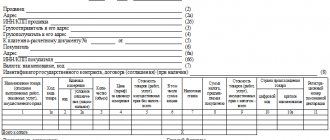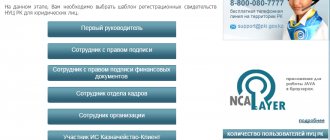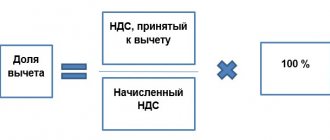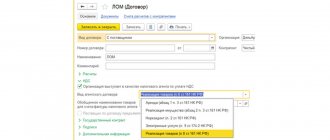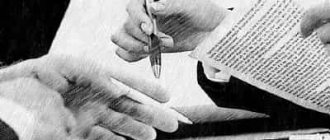There is an opinion that the norm enshrined in paragraph 1.1 of Article 172 of the Tax Code of the Russian Federation applies to goods, work and services, with the exception of fixed assets. Since for the latter, paragraph 3 of paragraph 1 of Article 172 of the Tax Code of the Russian Federation establishes a different norm. It says that deductions of VAT amounts presented by sellers to the taxpayer when purchasing fixed assets, equipment for installation or intangible assets specified in paragraphs 2 and 4 of Article 171 of the Tax Code of the Russian Federation are made in full after registration of these fixed assets, equipment for installation or intangible assets. Objections can be raised against this position from two sides at once.
As it was before
In the recent past, officials had a unequivocal opinion - it is prohibited to divide the VAT deduction for one invoice into different periods. Such conclusions can be found, for example, in letters of the Ministry of Finance dated December 9, 2010 No. 03-07-11/483, dated October 13, 2010 No. 03-07-11/408 and others. At the same time, the department’s specialists referred to the fact that such a procedure is not provided for by tax legislation. Indeed, Articles 171 and 172 of the Tax Code, devoted to deductions, did not contain rules directly allowing for the “scattering” of VAT deductions.
However, the majority of arbitration courts reasoned differently: firstly, the legislation does not directly prohibit deductions for partial applications, and, secondly, this does not lead to non-payment of tax. Therefore, the arbitrators in most cases recognized the splitting of the VAT deduction as legal. Similar conclusions are given, for example, in the Resolution of the Federal Antimonopoly Service of the Moscow Region dated February 12, 2013 No. F05-15985/12, as well as in many others.
Blog about taxes by Vladimir Turov
Good afternoon, colleagues.
Ask your accountant: “Is it possible to deduct VAT without an invoice?” Any accountant will tell you: “Never in my life.” And a professional accountant will refer to Articles 169 of the Tax Code of the Russian Federation and 172 of the Tax Code of the Russian Federation and say: “Never in your life will you be able to deduct VAT if there is no correctly drawn up invoice. No deduction, no refund."
If you've been to my seminars, I say the same thing every time... Yes, it's true. But the truth is also this. For example, you paid VAT to your supplier, contractor or subcontractor as part of the price for a service supplied, work performed, goods or raw materials. You have all the documents confirming the fact that this work was performed or the fact of this delivery, but there is no invoice. But this work was really done, and this is confirmed by papers. I have always said that VAT can still be deducted, and the court will be on your side.
Another example that I give at every seminar. Your drivers refuel at gas stations and receive an online receipt with a dedicated value added tax. Is it possible to deduct VAT using an online check?
Your accountant will be 100% right when he refers to Article 169 of the Tax Code of the Russian Federation or Article 172 of the Tax Code of the Russian Federation and says: “No, it is absolutely impossible to deduct VAT.” And the courts will be on your side if you deduct it.
This is possible for the simple reason that from the point of view of the logic of Chapter 21 of the Tax Code of the Russian Federation , which describes VAT, you are included in the price of a service, as part of the price of work, as part of the price of goods, raw materials or supplies, VAT to the budget, through your supplier or the contractor has already been paid. You have fulfilled your VAT obligation because you have a payment slip that says “payment with VAT” and an agreement that says “payment with VAT.” The money has been debited from your bank account, including VAT, and you have all the evidence. Colleagues, this is important.
So, the court decision that confirms this: Resolution of the Far Eastern District Court No. F03-1719/2018 dated May 31, 2020 in case No. A51-14757/2017. I quote: “Satisfying the requirements stated by the company, having examined and assessed the evidence presented in the case materials in their totality and interrelation, guided by the provisions of Articles 168, 169, 171, 172, 173, 176 of the Tax Code of the Russian Federation, the appellate court proceeded from the fact that the inaction of the counterparty under failure to issue an invoice cannot serve as an insurmountable obstacle to obtaining a VAT deduction by a bona fide taxpayer – LLC “...”, came to the conclusion that the company’s use of controversial tax deductions of VAT amounts is legal.”
You paid this VAT in good faith. You have all the papers, and even your employees confirmed that you really worked with this counterparty.
I consider this point to be extremely important. Because anything can happen with invoices. The signature is wrong, the seal is wrong, they didn’t receive it, they lost it, the counterparty doesn’t want to exhibit it for some reason... Maybe he’s unscrupulous, maybe he doesn’t want to pay VAT... But on the contrary, a conscientious businessman suffers. Therefore, be sure to study this court ruling.
Of course, the VAT problem is a universal problem. This problem is not only yours... I ask you to repost this article as much as possible: like it, forward it to your friends and acquaintances who work on the classical tax system, because they are faced with exactly the same situations.
We will talk in more detail about all the ways to reduce VAT, including at a seminar in Moscow on August 1-2. Come - you won't regret it.
Thank you, good luck with your business.
SIGN UP FOR A SEMINAR IN MOSCOW AUGUST 1-2
Links to the regulatory framework:
Resolution of the Far Eastern District Court No. F03-1719/2018 dated May 31, 2020 in case No. A51-14757/2017
(Visited 169 times, 1 visits today)
What changed
This contradiction in the positions of the Ministry of Finance and the courts persisted until January 1, 2020. But to the delight of taxpayers, the situation has changed - on the specified date, amendments to the Tax Code came into force. One of them concerned Article 172, which was supplemented by paragraph 1.1 . According to the norm contained therein, it is now possible to claim VAT deductions in any tax period within three years from the date of acceptance of goods for accounting . This gives companies the opportunity to manage the amount of deductions and claim them in the period when they consider it necessary.
In what cases is this convenient? For example, if the taxpayer wants to avoid indicating the amount of VAT to be refunded in the declaration. After all, in doing so, he may be faced with a full-fledged desk audit, within the framework of which the tax service has the right to demand all documents to justify the deduction. And many accountants, in order to avoid this, will prefer to declare the deduction partially, transferring the rest of it to later periods.
What deductions cannot be carried over?
VAT deductions for certain business transactions are not carried forward to other periods. This conclusion is made by the Ministry of Finance, guided by Art. 171 and 172 of the Tax Code of the Russian Federation.
For example, letter No. 03-07-11/67480 dated 10/17/17 states that all VAT amounts specified in Art. 171, (except for paragraph 2 of the same article) cannot be presented for three years, and in Art. 172-1 of the Tax Code directly states that deductions for fixed assets cannot be divided by periods.
The following operations are meant:
- for the acquisition of OS, intangible materials, equipment intended for installation;
- by prepayment;
- on the return of goods by the buyer, when contractual terms change, etc.
For these transactions, a deduction is made only in periods when the company has the right to it. Invoices are included in the declaration in full, and if this does not happen, an “adjustment” for the period is submitted. Otherwise, the right to deduct VAT amounts may be lost.
Briefly
- Transferring the VAT deduction to another period is possible within a 3-year period after the purchased goods are registered.
- Transfer is possible either in full or in parts.
- In order to avoid disputes with the Federal Tax Service, it is recommended not to delay submitting the deduction until the last quarter of the three-year period.
- Transferring the deduction allows the organization to create a “reserve” of VAT for the period when sales exceed the volume of purchases and reduce the tax burden. In this way, you can reduce the risk of an audit by the Federal Tax Service, which arises if a company submits a large amount for reimbursement from the budget.
- Transferring VAT to other periods is not possible for all purchases. Thus, the legislator requires deductions to be made for fixed assets, for prepayment and for some other transactions during the period when the right to it arises (Article 171, except for paragraph 2 of this article, Article 172, paragraph 1, paragraph 3 of the Tax Code of the Russian Federation).
New position of the financial department
The Tax Code still does not contain a direct rule allowing the deduction to be applied in parts - it only clearly allows it to be declared in tax periods within three years after the goods are accepted for accounting. However, now that flexible options for managing the deduction have appeared, the ban on its fragmentation loses all meaning . The position of Ministry of Finance officials has changed, which is reflected in letters No. 03-07-11/20290 and No. 03-07-11/20293 dated April 9, 2020. They conclude that splitting the VAT deduction for one invoice into several tax periods generally does not contradict the Tax Code.
The exception is transactions for the acquisition of fixed assets, equipment for installation and intangible assets - on the basis of paragraph 1 of Article 172 of the Tax Code of the Russian Federation, VAT on them is deducted in full after the said assets are accepted for accounting. In addition, splitting the deduction into several periods is unacceptable for VAT paid as a tax agent, as well as calculated from payment, prepayment and certain other transactions.
VAT on fixed assets as VAT on goods
In the specified paragraph 1.1 of Article 172 of the Tax Code of the Russian Federation, a reference is made to paragraph 2 of Article 171 of the Tax Code of the Russian Federation. The latter states that tax amounts presented to the taxpayer when purchasing goods, performing work, providing services, as well as when acquiring property rights are subject to deductions. But are fixed assets included in the concept of “goods” used in paragraph 2 of Article 171 of the Tax Code of the Russian Federation? In my opinion, definitely yes.
Novation of obligation. What about VAT?
Firstly, paragraph 3 of Article 38 of the Tax Code of the Russian Federation establishes that a product for the purposes of the Tax Code of the Russian Federation is any property sold or intended for sale. Purely theoretically, one could argue that this definition applies more to sellers of property than to buyers. However, secondly, we can turn to paragraph 8 of Article 145 of the Tax Code of the Russian Federation. It talks about the amounts of tax accepted by the taxpayer for deduction in accordance with Articles 171 and 172 of the Tax Code of the Russian Federation, before using the right to exemption from VAT on purchased goods, works, services, including fixed assets and intangible assets. That is, it is directly stated that the “acquired goods” include fixed assets. Consequently, at least within the framework of the chapter on VAT, the word “goods” also means fixed assets. This means that the provisions of paragraph 1.1 of Article 172 of the Tax Code of the Russian Federation also apply to them.
What does this look like in practice?
What is the procedure for an accountant if it is necessary to declare a VAT deduction in parts in different periods? Let's look at an example.
In the second quarter of 2020, Ajax LLC purchased a passenger car from Avtotrade LLC at a price of 944,000 rubles, including VAT of 144,000 rubles. The purpose of buying a car is further resale. The buyer's accountant decided to claim VAT deduction in equal installments until the end of the current year. Thus, a deduction in the amount of 48,000 rubles (1/3 of 144,000) will be declared in the II, III and IV quarters of 2020.
At the time of purchase, that is, in the second quarter of 2020, the following transactions are made:
| Wiring | Amount (RUB) | Operation description |
| Dt 08 Kt 60 | 800000 | car price excluding VAT |
| Dt 19 Kt 60 | 144000 | VAT amount |
| Dt 68 Kt 19 | 48000 | first part of VAT deduction |
In the same period, an invoice from Autotrade LLC in the amount of 48,000 rubles is registered in the Purchase Book of Ajax LLC.
In the following quarters of 2020, the accountant must repeat the last entry:
| Quarter 2015 | Wiring | Amount (RUB) | Operation description |
| III | Dt 68 Kt 19 | 48000 | second part of the VAT deduction |
| IV | Dt 68 Kt 19 | 48000 | third part of VAT deduction |
In each of these periods, you should also register an invoice from Autotrade LLC in the amount of 48,000 rubles. Thus, the invoice will appear in the Purchase Book not once indicating the full amount of VAT of 144,000 rubles, but three times for 48,000 rubles.
You can enter the second and third parts of the tax into the Purchase Book on any day of the corresponding period. For example, it is quite convenient to do this on the first day of the quarter.
By the same principle, the accountant of Ajax LLC could “split” the VAT deduction not into equal parts, but into arbitrary parts and into any number of periods within a three-year period from the moment the car was registered. Accepting the deduction in parts with “jumping” over one or more quarters also does not contradict the Tax Code. For example, if for some reason Ajax LLC had no sales operations in the fourth quarter of 2020, then it would be logical for the accountant to transfer the last part of the deduction to the first or any other quarter of 2016.
So, let’s summarize the main points of splitting the VAT deduction:
- You can claim part of the deduction in any quarter, the main thing is that the entire amount is “spent” within three years from the moment the goods are registered;
- the declared part of the deduction must correspond to an entry in the Purchase Book made in the same quarter and for the same amount;
- one invoice will be recorded in the Purchase Book several times in different quarters for an amount corresponding to the declared part of the deduction;
- when adding the partial deduction amounts, the VAT amount indicated on the invoice should be obtained.
How to transfer a deduction to another period
You can transfer a deduction on an invoice:
- the full amount;
- part of the amount.
If a large deduction, which “pulls” the calculations on the declaration towards reimbursement from the budget, needs to be postponed completely, an invoice from the supplier is entered into the purchase book of the quarter in which the amount should be paid. It will be reflected in the NU registers of the corresponding period and in the tax return for it.
If the company intends to carry out the transfer in parts, to divide it by periods, the invoice must be registered in the purchase book, declarations for all these periods, but not the full amount, but the part that should be included in the declaration. The total tax amount must match the invoice amount.
All tax settlements must be completed before the 3-year deadline. For example, if an invoice was issued on March 28, 2018, then the period expires on March 28, 2021. This means that the last amount on the document (full or partial) can be deducted no later than the 1st quarter of 2021.
However, there is a legal trap for taxpayers here. Literal interpretation of Art. 172-1.1 of the Tax Code allows the fiscal authorities to question the deduction presented in the last quarter. After all, the declaration for the period is submitted after its completion, before the 25th of the next month, “falling out” of the three-year period under the Tax Code of the Russian Federation. To date, judicial practice on this issue is not in favor of the taxpayer (opinion BC 308-KG18-12631 in case No. A32-32030/2017 dated 04/09/18). In order not to be refused, it is better to carry out the transfer without waiting for the deadlines specified in the law.
At the same time, there is a letter from the Ministry of Finance No. 03-07-11/27161 dated 05/12/15, which asserts the taxpayer’s right to deduct VAT no later than the tax period in which the 3-year period expires.
Deduction of VAT in parts and reconciliation of the Federal Tax Service
As you know, since the beginning of this year, the tax service has been carefully monitoring all VAT payers, processing their electronic reports automatically. At the same time, information from the books of purchases and sales of counterparties is compared, which have now become part of the expanded tax return. For each transaction, the data specified by the seller and the buyer are compared, including the amount of VAT.
However, if the buyer decides to “split” the deduction into several periods, then VAT will be partially reflected in his Purchase Book, which will not correspond to the entry in the supplier’s Sales Book. When conducting a cross-reconciliation at the end of the quarter, the tax office will identify this discrepancy and may require an explanation. Moreover, based on clause 8.1 of Article 88 of the Tax Code of the Russian Federation, the inspectorate will be able to demand the presentation of an invoice and other documents regarding the transaction, because formally the amount of tax in the buyer’s declaration will be underestimated. As a result, some accountants still prefer not to split deductions due to reluctance to communicate with the Federal Tax Service or fear of sanctions.
But according to many experts, it is completely safe to deduct VAT in parts. Of course, there is a risk of receiving a request from the inspectorate to provide explanations. But since by declaring a partial deduction, the buyer does not violate tax laws, he will be able to explain his actions, submit the necessary documents and without any problems “justify” the incomplete amount of VAT.
Determining the period for accepting VAT for deduction
From 2020, the payer has the right to choose periods for accepting tax for VAT deduction. Such adjustments have been made to Article 172. The payer has the right to transfer amounts to future periods for up to 3 years. Such actions are advisable if you need to avoid the tax refundable indicator in the declaration. In addition, this action is carried out so as not to exceed the safe share of deductions in the region.
According to the control authorities, the rule of 3 years does not apply to all amounts. The Ministry of Finance is against the possibility of transferring advance tax amounts. Amounts for goods and works, imports, services can be transferred to any quarter; there is no need to transfer to the next period.
The company has the right to request a return within 36 months after the goods or work were accepted for registration. It can be concluded that invoices for purchased goods can be recorded not only in the quarter when the right to reimbursement arises, but also later.
When purchasing fixed assets, the company has the right to issue deductions, which is confirmed by the Ministry of Finance. It is not recommended to partially claim a deduction under the SF for fixed assets, equipment and intangible assets. It is believed that such actions of the company are unlawful.
A deduction for entertainment expenses can be claimed when the advance report is approved. An organization has the right to accept tax refund only on expenses within the limits established for income tax.
The supplier has the right to accept a refund fee on the price of goods that were returned by the buyer. It can be declared within 12 months after the return of the product in accordance with Article 172 of the Tax Code. If the products have been accepted for registration by the buyer, an SF must be issued, on the basis of which the supplier will claim VAT deduction from the price of the returned goods.
When the supplier provides a discount for the buyer, he can accept the fee for return based on the adjustment SF. You can apply for a return within 36 months after drawing up the adjustment SF. Amounts from the advance payment should not be transferred to new periods. There is no norm in the Tax Code that allows this to be done.

